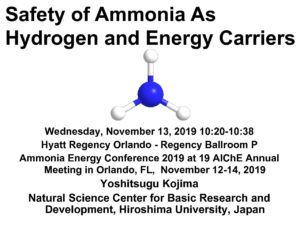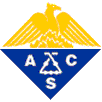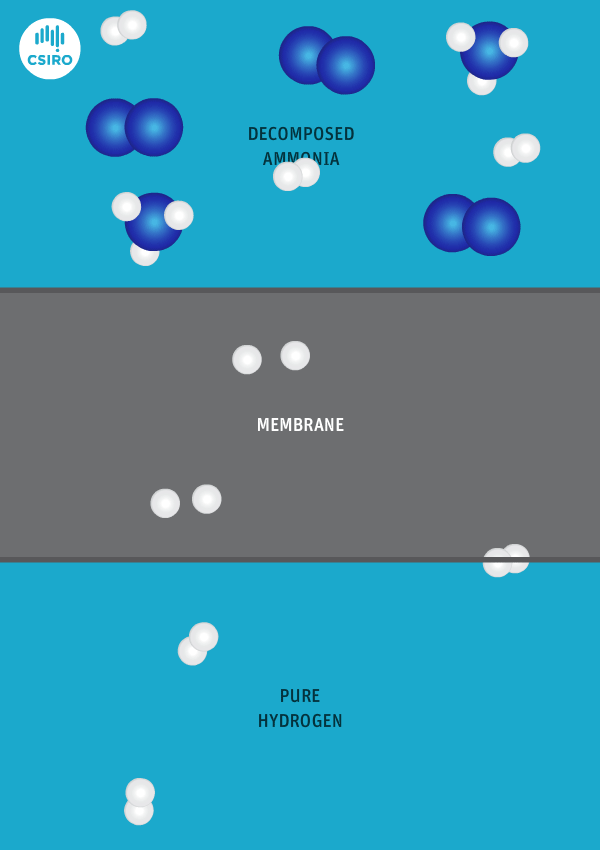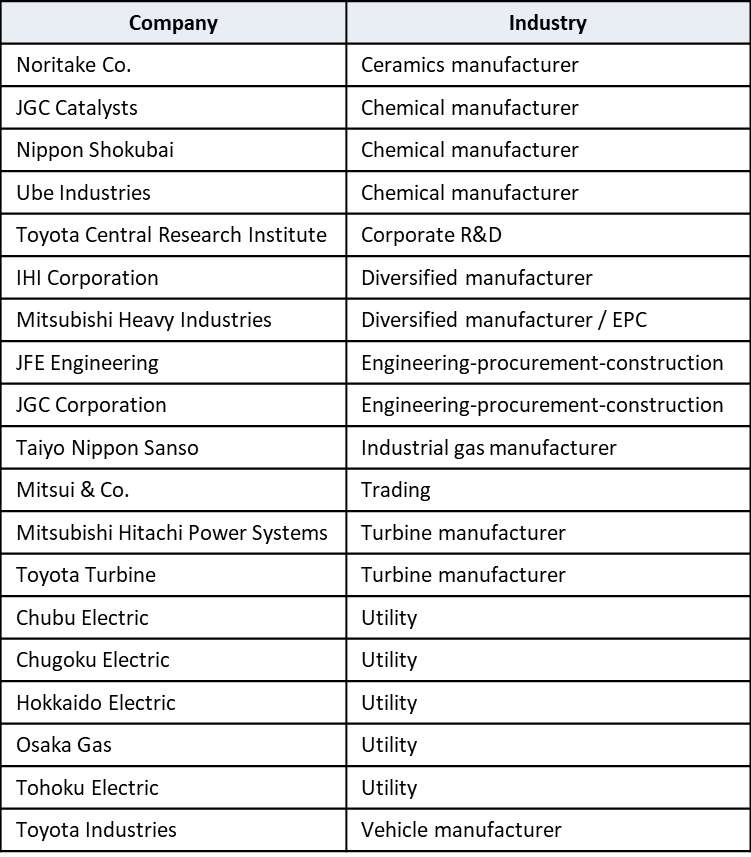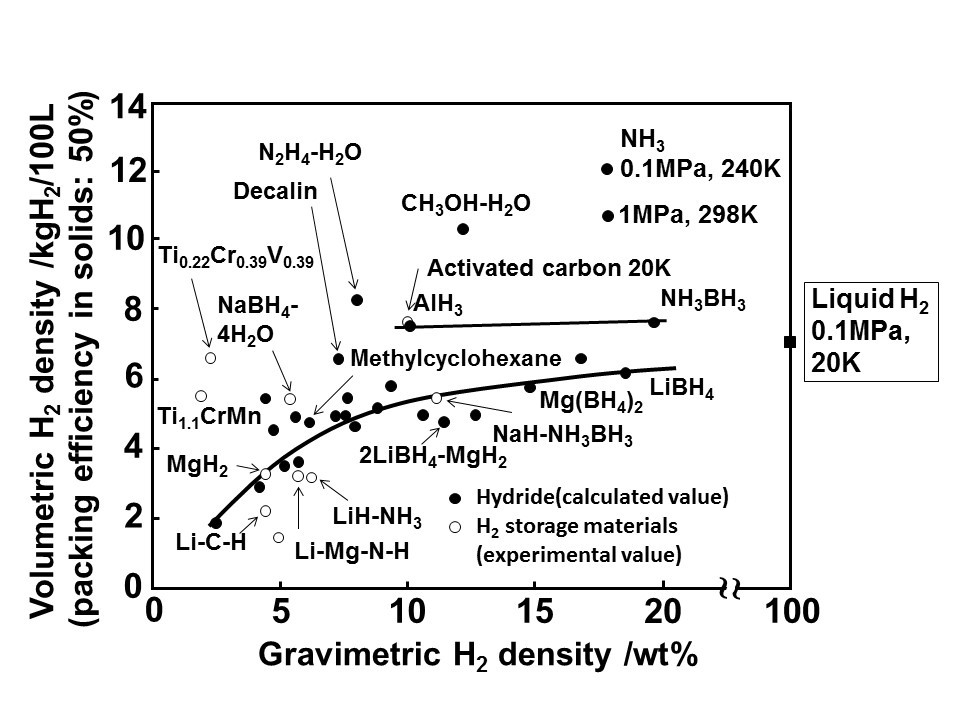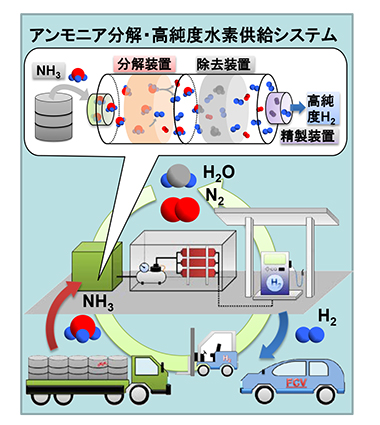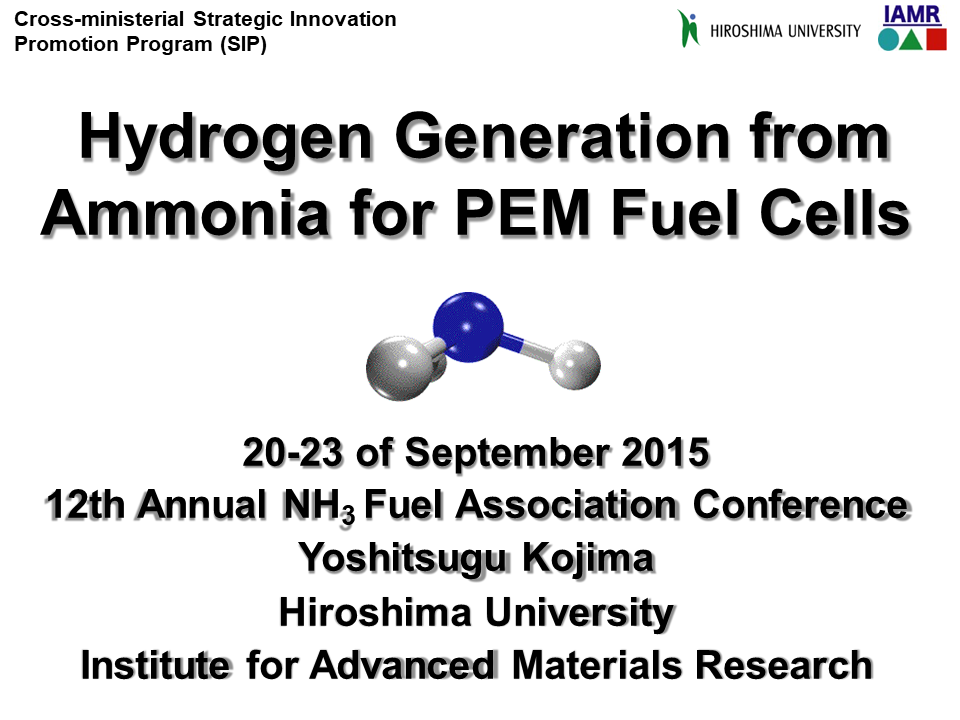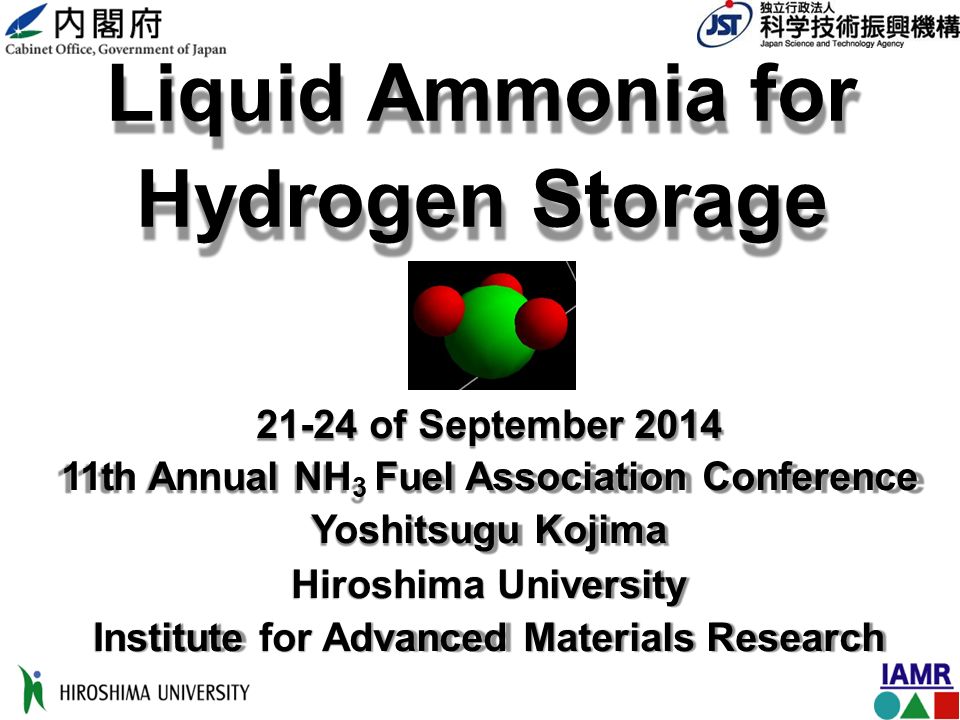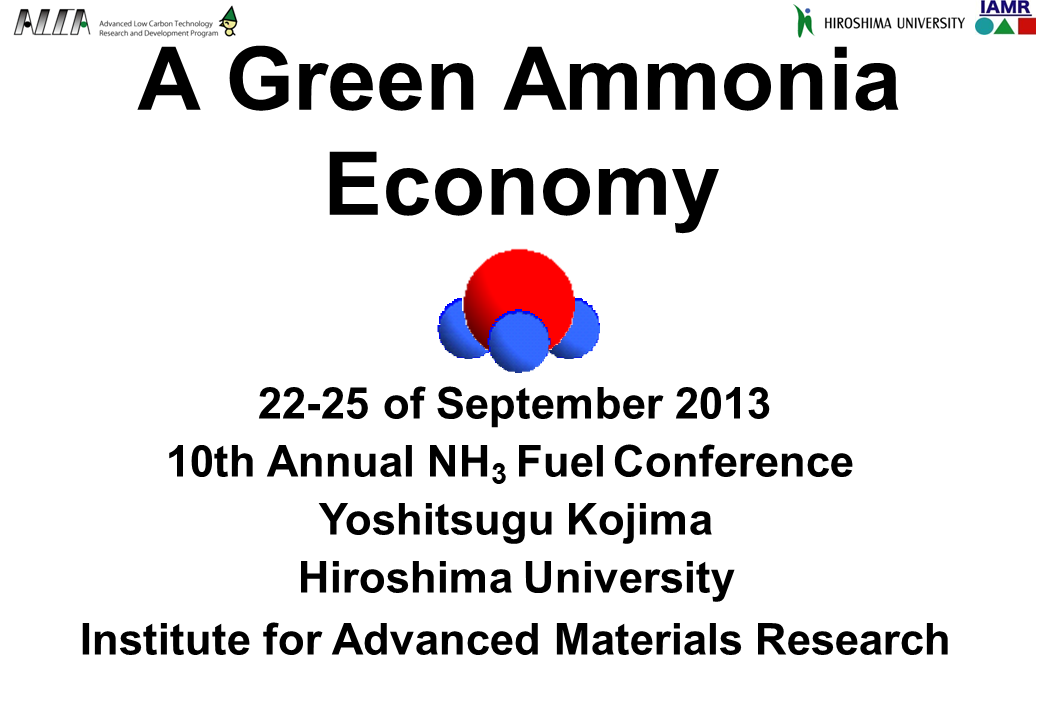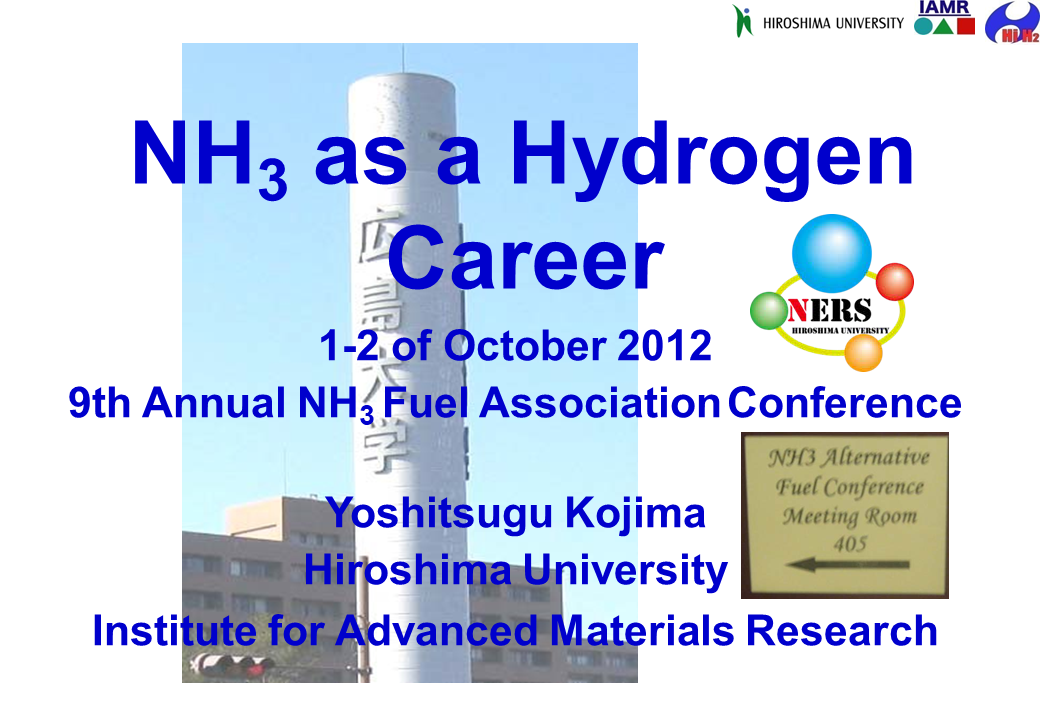Content Related to Hiroshima University
Presentation
Safety of Ammonia As Hydrogen and Energy Carriers
Ammonia (NH3) is liquefied at 1 MPa and 25 °C, and has a highest volumetric hydrogen density of 10.7 kg H2 /100L. It has a high gravimetric hydrogen density of 17.8 wt%. The heat of formation of NH3 is about 1/10 of combustion heat of hydrogen. NH3 has advantages as a hydrogen carrier for fuel cell vehicles and an energy carrier for power plants. In this research, the purpose is to figure out regulations for safety of NH3 in the world, and survey NH3 accident. We also characterize water as a NH3 absorbent. Regulations for flammability and health hazard are…
Presentation
Proton-Based Solid Acid for Ammonia Removal
Masakuni YamaguchiTomoyuki IchikawaHikaru MiyaokaKeita NakajimaTengfei ZhangHiroki MiyaokaYoshitsugu Kojima
Large amount of water is a NH3 absorbent in the plant facilities for emergency. NH3 and NH4+ coexist in ammonia water. For example, potential of hydrogen (pH) is 11 in 2500 ppm ammonia water and the ratio of NH3 and NH4+ are 98% and 2%, respectively. The aqueous solution releases NH3 due to the high equilibrium vapor pressure, resulting in increase of the negative effects on the environment. Therefore, in order to reduce ammonia released to the atmosphere, sulfuric acid is added in the aqueous solution. In this case, ammonium sulfate is formed and dissolves in the water. Therefore complicated…
Presentation
Ammonia As a Hydrogen Carrier for PEM Fuel Cells
Ammonia (NH3) is easily liquefied by compression at 1 MPa and 25°C, and has highest volumetric hydrogen density of 10.7 kg H2 /100L. It has high gravimetric hydrogen density of 17.8 wt%. The heat of formation of NH3 is about 1/10 of combustion heat of hydrogen. NH3 has advantages as a hydrogen carrier for fuel cell vehicles (FCVs). ISO 14687-2:2012 specifies the quality characteristics of hydrogen fuel. The maximum concentration of NH3 and N2 for the FCVs is 0.1ppm and 100 ppm, respectively. The minimum H2 purity is 99.97%. We need component technologies to produce high-purity hydrogen from ammonia, together…
Article
254th ACS Meeting, Energy and Fuels Symposium “The Ammonia Economy” — Oxidation, Catalytic Cracking & Storage
Martin Owen Jones October 31, 2017
In August of 2017 a symposium on the Ammonia Economy was held in Washington DC as part of the Energy and Fuels Division of the American Chemical Society (ACS) conference. The symposium was devised to explore the latest results from ammonia related research, including but not limited to; advances in the generation of ammonia, advances in the catalytic cracking of ammonia to nitrogen and hydrogen, ammonia storage and utilisation, detectors and sensors for ammonia, ammonia fuel cells and hydrogen from ammonia, ammonia combustion and ammonia safety.
Article
Progress toward Ammonia-to-Hydrogen Conversion at H2 Fueling Stations
Stephen H. Crolius October 05, 2017
In the last 12 months ... Groups in Australia, Japan, Denmark, the U.K., and the U.S. all made progress with technologies that can be used to convert ammonia to hydrogen at fueling stations. This means that hydrogen for fuel cell vehicles can be handled as ammonia from the point of production to the point of dispensing.
Article
Green Ammonia Consortium: Bright Prospects in Japan for Ammonia as an Energy Carrier
Stephen H. Crolius October 05, 2017
In the last 12 months ... In July 2017, 19 companies and three research institutions came together to form the Green Ammonia Consortium. Before this development, it was unclear whether ammonia would find a significant role in Japan’s hydrogen economy. In the wake of this announcement, however, ammonia seems to have claimed the leading position in the race among potential energy carriers.
Article
Major Development for Ammonia Energy in Japan
Stephen H. Crolius August 10, 2017
On July 25, the Japan Science and Technology Agency (JST) announced that a collection of companies and research institutions had come together to form a Green Ammonia Consortium. The 22-member group will take over responsibility for the ammonia aspect of the Cross-Ministerial Strategic Innovation Program (SIP) Energy Carriers agenda when the SIP is discontinued at the end of fiscal 2018. A JST press release states that the Consortium intends to develop a strategy for “forming [an] ammonia value chain,” promote demonstration projects that can further commercialization, and enable “Japanese industry to lead the world market.”
Article
The Ammonia Economy at the ACS National Meeting
Trevor Brown July 06, 2017
The American Chemical Society (ACS) has published the program for its 2017 National Meeting, which takes place next month in Washington DC and includes a session dedicated to the "Ammonia Economy." The first day of the week-long meeting, Sunday August 20th, will feature a full morning of technical papers from the US, UK, and Japan, covering ammonia energy topics across three general areas: producing hydrogen from ammonia, developing new catalysts for ammonia synthesis and oxidation, and storing ammonia in solid chemical form.
Article
On the Ground in Japan: FCV Uptake and Hydrogen Fueling Stations
Stephen H. Crolius June 01, 2017
Module four of the ten-module research and development agenda for Japan’s Cross-Ministerial Strategic Innovation Promotion Program -- Energy Carriers is entitled “Basic Technology for Hydrogen Station Utilizing Ammonia.” The rationale for including this technology is that “high purity H2 supply system with low cost hydrogen transportation is a key issue to spread fuel cell vehicles (FCVs).” A story published last week in the Tokyo Shimbun says that to date FCVs have not spread very far. Among the factors seen as constraints is the cost of hydrogen fueling stations (HFS). The Tokyo Shimbun story states that “according to industry officials, each station that supplies hydrogen to fuel cell vehicles runs about ¥400 million ($3.6 million) in construction costs. In order to achieve profitability, about 1,000 fuel cell vehicles are required as customers per location. Construction is not proceeding.” So far, the players focused on FCVs do not seem to be looking to ammonia as an expedient that will help reduce the cost of HFS and thereby encourage their construction and by extension the uptake of FCVs. This appears to be a missed opportunity whose benefits may become too compelling to ignore.
Article
Hydrogen Fueling Station Development in Japan
Stephen H. Crolius February 03, 2017
Two announcements – focused on very different approaches for supplying hydrogen as a transportation fuel – shine a light on Japan’s approach to creating a national hydrogen energy economy. On January 24, the American company Air Products and Chemicals, Inc. issued a press release about the launch of the Shikaoi Hydrogen Farm fueling station in Hokkaido, Japan. The station will be supplied by hydrogen derived from agricultural wastes via anaerobic digestion and Air Products’ biogas purification and steam methane reforming (SMR) technologies. The project was undertaken by a consortium that includes the Japanese companies Nippon Steel and Sumikin Pipeline & Engineering, Air Water, Inc., and Kajima Corporation. Six months earlier, on July 19, 2016, the Japan Science and Technology Agency (JST) announced that another consortium – this one led by Hiroshima University and including Showa Denko, Taiyo Nichi Company, and Toyota Industries – had succeeded in developing “viable technology to produce high-purity hydrogen [from an] ammonia hydrogen station.”
Presentation
Hydrogen Generation from Ammonia for PEM Fuel Cells
Hydrogen Generation from Ammonia for PEM Fuel Cells Yoshitsugu Kojima, Institute for Advanced Materials Research, Hiroshima University
Presentation
Liquid Ammonia for Hydrogen Storage
Hydrogen storage and transportation technology is essentially necessary to realize hydrogen economy. Hydrogen can be stored in many different forms, as compressed or liquefied hydrogen in tanks, or as hydrogen carriers: a hydrogen-absorbing alloy, metal hydrides with light elements, organic hydrides and carbon-based hydrogen storage materials. Among them, solid-state hydrides with light elements such as MgH2, Mg(BH4)2 and NH3BH3 possess high hydrogen capacity, 7-20 mass%, However, the practical volumetric H2 density is below 8 kgH2/100L because the packing ratio is down to 50%. Ammonia is easily liquefied by compression at 1 MPa and 25°C, and has a high volumetric hydrogen…
Presentation
A Green Ammonia Economy
Ammonia has a high volumetric hydrogen density of 107.3 kg H2 per cubic meter, because it is easily liquefied by compression below 0.86 MPa at 20° C. The vapor pressure of liquefied ammonia is similar to propane. Moreover it has a high gravimetric hydrogen density of 17.8 mass% compared with the solid state hydrogen storage materials. It is noteworthy that ammonia can be synthesized from hydrogen in large scale manufacturing by Haber–Bosch process at 400-600° C and 20-40 MPa. Therefore, liquid ammonia is one of the most promising methods for storing and transporting hydrogen. CO2 free hydrogen (ammonia) will be…
Presentation
NH3 as a Hydrogen Carrier
NH3 as a Hydrogen Carrier Yoshitsugu Kojima and Takayuki Ichikawa, Hiroshima University
